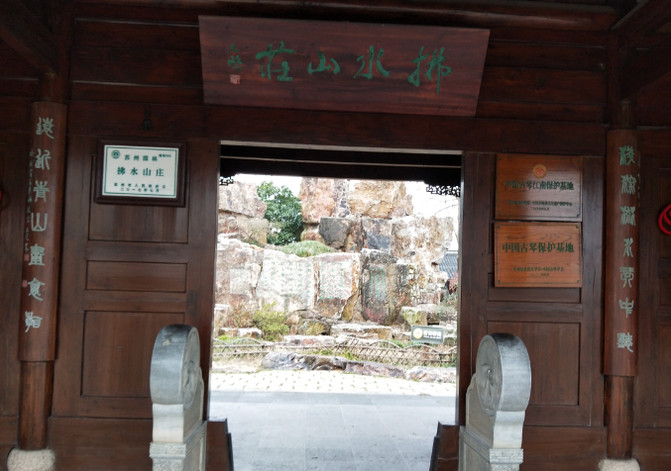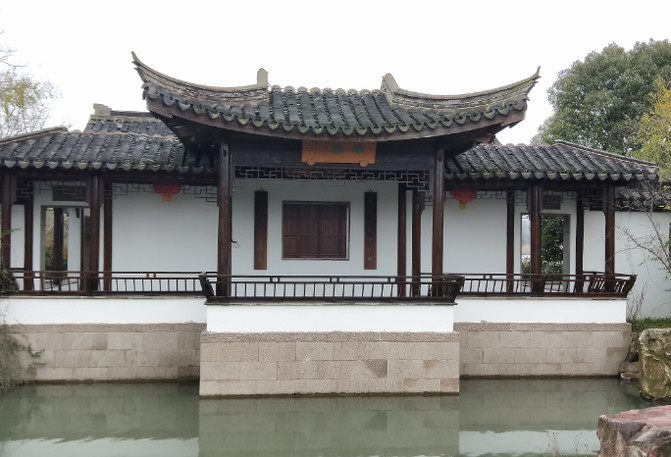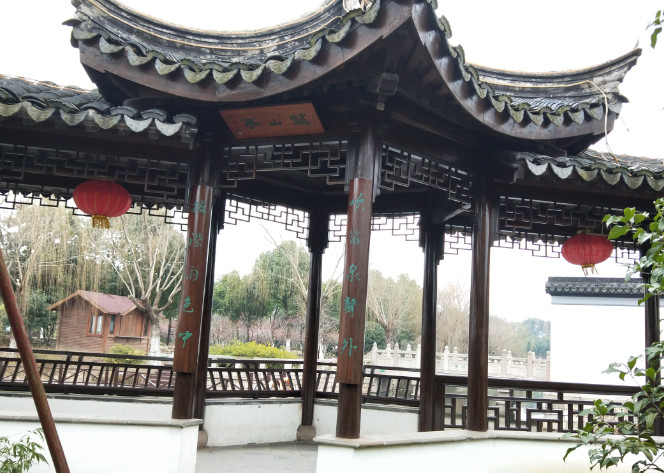Fushui Villa is a paradise for talented and beautiful people
★ Tourist location: Fushui Villa, Shanghu, Changshu, Suzhou
Because the last time I came to Shanghu, I was eager to see the peonies, but I only glanced past Fushui Villa, so I was worried about it for half a year. Finally, I visited again in late winter and early spring. After a stroll around Taigong Island, I headed straight for Fushui Villa.

The villa is famous for its love story between Qian Lianyi, the Southeast Wen Zong in the late Ming and early Qing Dynasties, and Liu Ru, a talented girl of a generation. Compared with Qian Qianyi, a literati, I prefer Liu Ru, who came from a brothel but has a proud character. There were many talented women born in the Qinhuai River in the late Ming and early Qing Dynasties. They truly combined beauty and talent. It was only because of their poor skills in reincarnation that they fell into the dust. They are all good at singing and dancing, and have extraordinary literary talents. Qinhuai Bayan is one of the best. Liu Rushi ranks first among the eight beauties of Qinhuai, not only because she is older among the eight beauties, but also because her talent ranks first among the eight beauties. And her talent and reputation have been pushed to a new peak because of Qian Qianyi's high-profile marriage. After all, with the admiration of Southeast Wenzong, who dares to underestimate this woman's talent?

Entering from the entrance, we chose a counterclockwise route because I thought the scenery by the lake was the most beautiful. In fact, it is indeed the case. This area is intertwined with lakes and rocks, with pavilions and towers scattered among them. The view is wide and exquisite.

The Chaoyang Pavilion was built in the lake. It was a rectangular pavilion. A doorway was made on the side facing the lake and some white walls were added to slightly block it. Looking out from the door, it looks like a natural long axis scroll. There is also a Chronicle of Chaoyang Pavilion in the pavilion, which records the origin of the pavilion's name. It turned out to be derived from Erya. Because of its connection with the Book of Songs, the two very common words Chaoyang have become a little more bookish and have obviously improved two levels.

From here, we can see the scene of Shanghu and withered lotus branches, so that we can only relive the midsummer scene of the garden full of lotus fragrance in our imagination. In addition to the peony flower fair in April, the lotus flowers in Shanghu are also very beautiful.

Wenyong Pavilion is an open pavilion of square pavilions connected by a folded bridge to the center of the lake. There are withered lotus trees all around. In midsummer, this should be one of the best places to enjoy lotus trees in Shanghu.

In addition to Taihu Lake outside, there is also a lake enclosed along the stone road. It can be regarded as a lake in the lake and is included in the scope of the villa, not just a scenic spot.

There is a piece of yellowstone by the lake on the side, engraved with the words "Fishing for Qingliu". Qian Qianyi was himself a literati leader in the southeast, and it was nothing to regard himself as a clear person. However, when the Qing army entered the city, he refused Liu Rushi's proposal to sacrifice his life for the country because the water was too cold. He really couldn't be "noble".
Huaxin Tower is a two-story building with three rooms wide. There are railings and corridors on the second floor, and antique palace lanterns are hung. The two red lanterns under the eaves have a little ruined the overall aesthetic feeling.

Flower letter is a very beautiful word. Only when a woman reaches the best years of her life can she be called Flower letter years. The layout in the building is also very talented in the style of a talented woman. Qin, chess, calligraphy and painting are naturally indispensable. A guqin is placed in the center, so that tourists can show off their hands.
The door of Qian's Tea House is closed, and it is estimated that it will not open until the spring is warm and the flowers are in full bloom. But we weren't too interested in drinking tea, so we went to the door, took a look at it for a while, and left.

However, a wintersweet flower in front of the door was still in full bloom, which instantly raised the appearance of the tea room by one or two degrees. Tourists who walked past the tea house were all stopped by this.

Walking along the corridor on the side, you can see plum blossoms across the bank. It turned out that there was still a piece of Merlin there! Although spring has not yet arrived, Shanghu has begun to bloom its spring.

Mingfa Hall has three rooms wide and its doors are also closed. The two stone lions in front of the door made us feel solemn for no reason, but we didn't know what it looked like inside.

Binghe Xuan is a pavilion open on three sides. One side is a wooden wall, carved with many mountains, rivers and flowers. The four pieces on the roof of the pavilion are horizontally placed, and the sixteen pieces below are vertically placed in two rows. The whole pavilion looks very classical. There are also stone tables and stone benches in the pavilion, allowing visitors to rest and enjoy the beautiful scenery of the villa.

Facai Pavilion is a six-corner exquisite pavilion. In fact, it is more interesting when viewed from a distance than when viewed up close. Although the pavilion is also very exquisitely built, the pillars of the pavilion are still engraved with couplets.

There is a group of buildings coupled to farming halls next to it, and from the foyer there is a patio. The doors of the building behind were closed, but looking in through the glass windows, this was the place where the flower arrangement exhibition was held.

Tuanguitian Fragrance Pavilion is an open pavilion with a see-through screen in the middle, which blocks it slightly but does not affect the line of sight. In the pavilion, you can look at the buildings on the other bank across the lake, but the withered lotus and reed trees allow your line of sight to be almost unobstructed.

Meipu River Hall is not open either. The three-room bungalow seems to be the standard feature of the villa. Many buildings are in this style, so we often get lost in a gorgeous way. The plum blossoms in front of the house bloom very well, pink and tender, like a lively and playful little girl.
Next to it, there is a Moon Cave Gate that leads to Qingfeng Tingquan. It is said to be a spring, but it is also built artificially. But there are black swans cruising on a small island next to it.

Autumn Water Pavilion is a relatively large group of buildings built next to the water. In addition to the second floor of the main building, there are also two pavilions. They look at the mountains and the water, and are surrounded by water on both sides. The scenery from the outside is also very beautiful.

Originally, I am not a person who likes artificial attractions, but Fushui Villa makes good use of a corner of Shanghu. Although the house is newly built, it is not built in a uniform pattern of white walls and dresses. Instead, it uses the color of logs. The overall style is unified, creating an antique Qing Dynasty architectural complex.

Walking out of Fushui Villa after passing the small bridge, there is a plum blossom forest at the door. The pink, white, red and green plum blossoms are in full bloom. Later, there will be a crabapple forest here.

Not far away is Zhangmu Bridge, which seems to be old. There is no beautiful arch to form a complete circle with the reflection in the water, but it seems to be perfect here.

There is a two-wing pavilion beside the bridge. I immediately thought it was to commemorate the love story of Qian Qianyi and Liu Rushi. I was wondering why it was not placed in Fushui Villa. When I turned around, I found that the pavilion was shaped like two wings of a bird. It is actually made up of two pavilions, only borrowing the middle part.

Miwu Bridge should be newly built with corridors on the bridge. Liu Ru is nicknamed Miwu Jun. She loves plants Miwu and often uses them as sachets. This bridge is of course built in memory of Liu Ru.



















